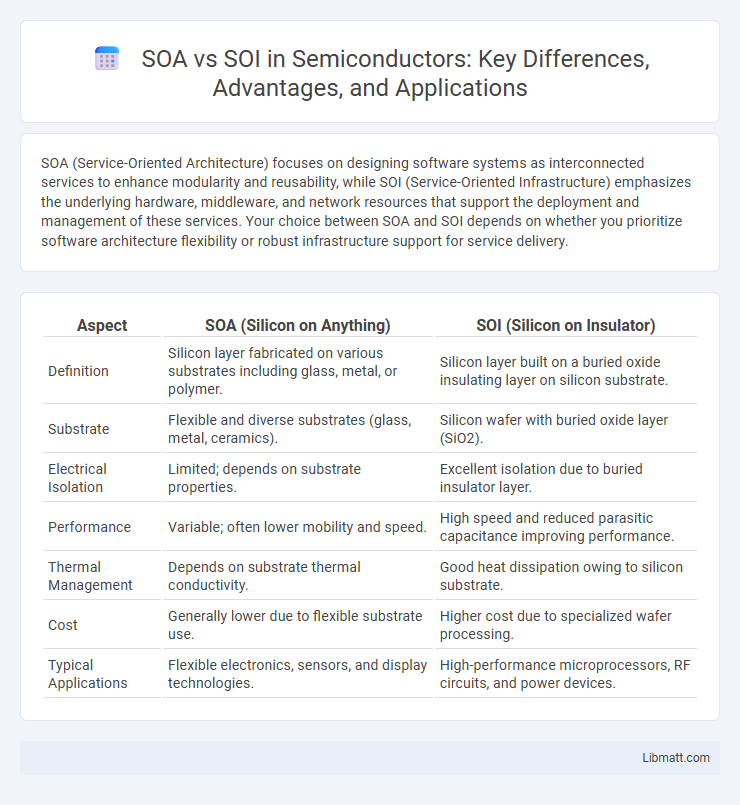SOA (Service-Oriented Architecture) focuses on designing software systems as interconnected services to enhance modularity and reusability, while SOI (Service-Oriented Infrastructure) emphasizes the underlying hardware, middleware, and network resources that support the deployment and management of these services. Your choice between SOA and SOI depends on whether you prioritize software architecture flexibility or robust infrastructure support for service delivery.
Table of Comparison
| Aspect | SOA (Silicon on Anything) | SOI (Silicon on Insulator) |
|---|---|---|
| Definition | Silicon layer fabricated on various substrates including glass, metal, or polymer. | Silicon layer built on a buried oxide insulating layer on silicon substrate. |
| Substrate | Flexible and diverse substrates (glass, metal, ceramics). | Silicon wafer with buried oxide layer (SiO2). |
| Electrical Isolation | Limited; depends on substrate properties. | Excellent isolation due to buried insulator layer. |
| Performance | Variable; often lower mobility and speed. | High speed and reduced parasitic capacitance improving performance. |
| Thermal Management | Depends on substrate thermal conductivity. | Good heat dissipation owing to silicon substrate. |
| Cost | Generally lower due to flexible substrate use. | Higher cost due to specialized wafer processing. |
| Typical Applications | Flexible electronics, sensors, and display technologies. | High-performance microprocessors, RF circuits, and power devices. |
Introduction to SOA and SOI
Service-Oriented Architecture (SOA) is a design approach that structures software as reusable, interoperable services to enhance flexibility and integration across heterogeneous systems. Service-Oriented Infrastructure (SOI) complements SOA by providing the underlying hardware, networks, and virtualization technologies necessary to support dynamic service deployment and scalability. Together, SOA and SOI enable organizations to build agile IT environments that optimize resource utilization and improve service delivery.
Defining Service-Oriented Architecture (SOA)
Service-Oriented Architecture (SOA) is a design paradigm that organizes software components as interoperable services, enabling flexible and scalable business processes. SOA emphasizes loose coupling, reusability, and standard communication protocols, facilitating integration across diverse systems. Understanding SOA allows your organization to build modular applications that improve agility and streamline IT infrastructure.
Understanding Service-Oriented Infrastructure (SOI)
Service-Oriented Infrastructure (SOI) refers to the architectural framework that enables the dynamic provisioning and management of IT resources through standardized, service-oriented methods, focusing on infrastructure components such as servers, storage, and networking. Unlike Service-Oriented Architecture (SOA), which emphasizes the design and integration of business services using loosely coupled software components, SOI concentrates on the underlying physical and virtual resources necessary to support those services efficiently and flexibly. Understanding SOI is crucial for optimizing resource utilization, improving scalability, and ensuring seamless service delivery in cloud computing and enterprise environments.
Key Components of SOA
Service-Oriented Architecture (SOA) is built on key components such as services, service consumers, service providers, and service registries that enable interoperability and reusable software modules. These components facilitate dynamic communication and integration across distributed systems by defining standardized interfaces and protocols. Understanding these elements helps you design scalable, flexible architectures that align with business processes and IT goals.
Core Elements of SOI
The core elements of a Service-Oriented Infrastructure (SOI) include virtualization, automation, and standardized service catalogs that enable dynamic resource allocation and efficient management of IT resources. SOI emphasizes integrating hardware, network, storage, and virtualization technologies under a unified management framework to support service-oriented architecture (SOA) principles. This infrastructure allows for improved scalability, flexibility, and cost-efficiency compared to traditional IT infrastructures by enabling services to be provisioned and orchestrated on demand.
SOA vs SOI: Main Differences
SOA (Service-Oriented Architecture) organizes software as reusable, loosely coupled services that communicate over a network, enabling flexibility and scalability in system design. SOI (Service-Oriented Infrastructure) supports SOA by providing the underlying physical and virtual resources, including servers, storage, and networking, optimized for service delivery and management. Understanding the main differences between SOA and SOI helps you architect efficient systems by aligning service design with the appropriate infrastructure capabilities.
Benefits of Adopting SOA
Adopting Service-Oriented Architecture (SOA) enhances your organization's agility by enabling reusable, loosely coupled services that improve integration across diverse systems. SOA facilitates streamlined business processes and faster response to market changes through standardized interfaces and interoperable components. This architectural approach reduces development costs and accelerates time-to-market by promoting modular design and efficient resource utilization.
Advantages of Implementing SOI
Implementing Service-Oriented Infrastructure (SOI) enables organizations to achieve higher scalability and agility by decoupling hardware resources from specific services, leading to more efficient resource utilization and simplified maintenance. SOI enhances integration capabilities across heterogeneous IT environments, facilitating seamless service delivery and consistent performance. The approach also improves security and virtualization management, optimizing operational costs while supporting dynamic, service-based business processes.
Use Cases: When to Choose SOA or SOI
SOA (Service-Oriented Architecture) is ideal for large enterprises requiring integration across diverse systems and platforms, supporting complex workflows and reusable services. SOI (Service-Oriented Infrastructure) is best suited for organizations focusing on optimizing and automating their IT infrastructure to improve scalability, agility, and resource management. You should choose SOA for application-level integration and business process alignment, while SOI is preferred when enhancing the underlying infrastructure supporting these services.
Future Trends in SOA and SOI
Future trends in SOA (Service-Oriented Architecture) emphasize increased adoption of microservices and event-driven architectures, enhancing scalability and real-time processing. SOI (Service-Oriented Infrastructure) is evolving toward automated, AI-driven infrastructure management to optimize resource allocation and improve service delivery efficiency. Understanding these trends enables you to strategically plan your IT architecture for agility and continuous innovation.
SOA vs SOI Infographic

 libmatt.com
libmatt.com